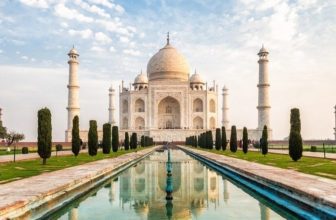Home » Sustainable Insights ( Blogs ) » Monday Flashback 22 – Panch Mahal, Fatehpur Sikri, Uttar Pradesh
Monday Flashback 22 – Panch Mahal, Fatehpur Sikri, Uttar Pradesh
The Panch Mahal meaning `wind catcher tower’ was commissioned by Mughal Emperor Akbar This structure stands close to the Zenana quarters (Harem) which supports the supposition that it was used for entertainment and relaxation. This is one of the most important buildings in Fatehpur Sikri. This is an extraordinary structure employing the design elements of a Buddhist Temple; entirely columnar, consisting of four stories of decreasing size arranged asymmetrically on the ground floor, which contains 84 columns. These columns, that originally had jaali (screens) between them, support the whole structure. Once these screens provided purdah (cover) to queens and princess on the top terraces enjoying the cool breeze and watching splendid views of Sikri fortifications and the town nestling at the foot of the ridge.
The pavilion gives a majestic view of the fort that lies on its left. The pool in front of the Panch Mahal is called the Anoop Talab. It would have been filled with water, save for the bridge, and would have been the setting for musical concerts and other entertainment. The ground floor has 84 columns, the first story has 56 columns and the second and third stories have 20 and 12 columns respectively. The topmost story has 4 columns supporting a chhattri. There are 176 columns in all and each is elegantly carved pillars with unique designs.
 Fatehpur Sikri, known for its architecture and planning, is situated in Northern India close Agra, was worked by Akbar, the third Mughal ruler, in 1571 , as his new capital. The significant piece of the complex was manufactured/built in a limited capacity to focus four to ten years, utilizing neighborhood building aptitudes and materials.
Since the territory is near the western desert area, the atmosphere is hot-dry with generally little precipitation.
Fatehpur Sikri, known for its architecture and planning, is situated in Northern India close Agra, was worked by Akbar, the third Mughal ruler, in 1571 , as his new capital. The significant piece of the complex was manufactured/built in a limited capacity to focus four to ten years, utilizing neighborhood building aptitudes and materials.
Since the territory is near the western desert area, the atmosphere is hot-dry with generally little precipitation.


 At the outskirts, where the slants are troublesome, bring down structures are worked as props to empower simple development to finish everything. The lower structures are for the most part benefit offices congenial from the lower streets and interconnected with upper levels by steps.
A detailed water supply framework existed, enacting the direct channels and tanks at the upper patio level. The seven passage doors punctured in the city divider prompt real settlements in the areas of which the Agra entryway is the most vital (since Akbar had effectively fabricated his fortress there).
This street lies indistinguishable way from the edge and steadily ascends to give access to the royal residence complex to finish everything. The introduction of the mosque and the royal residence complex is toward Mecca while the other city structures watch the land shape as a noteworthy determinant.
At one time, the town was spread on all sides of the edge and the castle region had a fantastic perspective of the region around. Minor level changes exist between patios which are consulted by steps and are keenly abused for gravitational stream of water.
At the outskirts, where the slants are troublesome, bring down structures are worked as props to empower simple development to finish everything. The lower structures are for the most part benefit offices congenial from the lower streets and interconnected with upper levels by steps.
A detailed water supply framework existed, enacting the direct channels and tanks at the upper patio level. The seven passage doors punctured in the city divider prompt real settlements in the areas of which the Agra entryway is the most vital (since Akbar had effectively fabricated his fortress there).
This street lies indistinguishable way from the edge and steadily ascends to give access to the royal residence complex to finish everything. The introduction of the mosque and the royal residence complex is toward Mecca while the other city structures watch the land shape as a noteworthy determinant.
At one time, the town was spread on all sides of the edge and the castle region had a fantastic perspective of the region around. Minor level changes exist between patios which are consulted by steps and are keenly abused for gravitational stream of water.
 Fatehpur Sikri, known for its architecture and planning, is situated in Northern India close Agra, was worked by Akbar, the third Mughal ruler, in 1571 , as his new capital. The significant piece of the complex was manufactured/built in a limited capacity to focus four to ten years, utilizing neighborhood building aptitudes and materials.
Since the territory is near the western desert area, the atmosphere is hot-dry with generally little precipitation.
Fatehpur Sikri, known for its architecture and planning, is situated in Northern India close Agra, was worked by Akbar, the third Mughal ruler, in 1571 , as his new capital. The significant piece of the complex was manufactured/built in a limited capacity to focus four to ten years, utilizing neighborhood building aptitudes and materials.
Since the territory is near the western desert area, the atmosphere is hot-dry with generally little precipitation.

Planning and Architecture Features
The Fatehpur Sikri complex stands on an edge and the city is encased by an embattlement on three sides and on the fourth by an immense counterfeit lake which was the primary wellspring of water supply to the city. The edge is to some degree in the focal point of this walled territory and keeps running from South-West to North-East. All the significant structures of the complex are situated over this edge , using a similarly level territory.
 At the outskirts, where the slants are troublesome, bring down structures are worked as props to empower simple development to finish everything. The lower structures are for the most part benefit offices congenial from the lower streets and interconnected with upper levels by steps.
A detailed water supply framework existed, enacting the direct channels and tanks at the upper patio level. The seven passage doors punctured in the city divider prompt real settlements in the areas of which the Agra entryway is the most vital (since Akbar had effectively fabricated his fortress there).
This street lies indistinguishable way from the edge and steadily ascends to give access to the royal residence complex to finish everything. The introduction of the mosque and the royal residence complex is toward Mecca while the other city structures watch the land shape as a noteworthy determinant.
At one time, the town was spread on all sides of the edge and the castle region had a fantastic perspective of the region around. Minor level changes exist between patios which are consulted by steps and are keenly abused for gravitational stream of water.
At the outskirts, where the slants are troublesome, bring down structures are worked as props to empower simple development to finish everything. The lower structures are for the most part benefit offices congenial from the lower streets and interconnected with upper levels by steps.
A detailed water supply framework existed, enacting the direct channels and tanks at the upper patio level. The seven passage doors punctured in the city divider prompt real settlements in the areas of which the Agra entryway is the most vital (since Akbar had effectively fabricated his fortress there).
This street lies indistinguishable way from the edge and steadily ascends to give access to the royal residence complex to finish everything. The introduction of the mosque and the royal residence complex is toward Mecca while the other city structures watch the land shape as a noteworthy determinant.
At one time, the town was spread on all sides of the edge and the castle region had a fantastic perspective of the region around. Minor level changes exist between patios which are consulted by steps and are keenly abused for gravitational stream of water.
Composite climate occurs in most of the areas ruled by Mughals in North India which is characterized by dominated hot and dry conditions two third of the year and, a somewhat cold and a warm
humid season occur in the remaining one third of the year. Being sufficiently far from the equator, this region experiences clear seasonal changes in solar radiations and wind directions. The remarkable mean diurnal changes may be observed from 11-12° C in hot dry and cool dry seasons while this range narrows up to 3-6° C in warm humid season. Relative humidity reaches up to 95% during the wet period. There is little or no rain during dry season. Hot and dusty winds blow during dry season. However monsoon winds are strong and steady (Koenisberger, 2001). Dominated hot and dry season remained a problematic situation in this region throughout the centuries. Even Babur, the first Mughal ruler in India complained about the dusty winds and climate of the region in his memoir ’Tuzik-i-Babri’ (Grover, 2002).
Microclimate Control
The gardens of paradise mentioned in the Holy Quran have been the source of inspiration throughout the Islamic world (Kausar, 2005). Mughals also used this tool not only as a symbol but to improve the quality of the immediate surrounding environment of their buildings. The environment outside the building is important to control the inside temperature
of the building. The external air is treated by improving microclimate of the region which consequently enhances the quality of air inside the building. Vegetation was added to improve
the quality of outer spaces and to enhance cooling by evapo-transpiration. The process of evapo-transpiration adds water vapors to the air and brings down the air temperature. The water bodies (still and moving) were added to the palaces to improve the humidity in hot and dry regions Fountains are the better way to improve the quality of air as it sprinkles the water drops into the air and make the process of evaporation faster. Mughals also used fountain in their buildings. These water channels and fountains are found frequently inside the buildings. Nahar-i-Bahisht (canal of paradise) is an example of water channel which passes through internal spaces of the building to modify internal environment. Most of the Mughal buildings are surrounded by a landscaped area to modify the microclimate of the region.
SaveSavedRemoved 0








